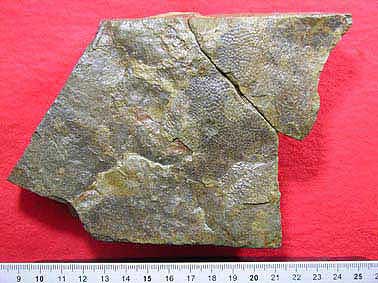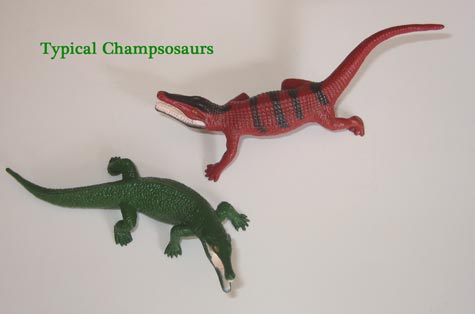Dinosaur Skin with Fine Scales or Is it a Dinosaur Fossil at All?
Japanese scientists have published a description of a dinosaur skin impression found in Kumamato Prefecture (Japan).
The country of Japan is not well-known for its dinosaur fossils. Situated on the notorious “ring of fire” in the Pacific, the islands that make up Japan are subjected to considerable seismic forces. However, a number of important dinosaur discoveries have been made by geologists and palaeontologists as they study sedimentary rocks laid down in the Mesozoic Era. Isolated teeth representing a yet unknown genus of large theropod (meat-eating) dinosaur have been found in Hakusan, Ishikawa Prefecture on the northern coast of Japan’s main island.
The teeth have been dated to the Early Cretaceous and they suggest that if there were apex predators living in the area that was to form the islands of Japan then there would have been a substantial and thriving dinosaur-based eco-system with many more types of plant-eating dinosaur for the large carnivores to prey upon. Fossils of giant plant-eating dinosaurs known as sauropods have also been found, most notably a fragmentary fossil of a leg bone from a huge, long-necked dinosaur. Representatives from the Palaeontological Society of Japan reported on the finding of a huge sauropod femur (the thigh bone of a sauropod). This single fossil represents the largest type of dinosaur found in the country to date.
To read about the discovery of the giant dinosaur femur: Sauropod Femur Discovered in Japan.
Dinosaur Skin Impression
Japanese scientists have just published the description of a remarkably well-preserved fossil which shows the imprint of a dinosaur’s skin. The fossil measures a little under twenty centimetres in length and eleven centimetres wide at its widest part. Although the discovery of a dinosaur skin impression has yet to be confirmed, if the find is validated then this is only the second time that an impression of a dinosaur’s skin has been found in the country.
The fossil was found in 2001 by an amateur fossil hunter, exploring a series of ninety-eight-million-year-old, fine sandstone deposits in Amakusa, Kumamato Prefecture. It actually consists of two pieces, as the fossil had been broken up as a result of weathering at the site. The first section the forms the top, right portion of the fossil was found and then a few months later the second part of the fossil, representing the larger, lower portion of the fossil material was found.
For much of the Mesozoic Era the series of islands that make up the country we now know as Japan lay underwater, however, what land that remained above sea level was part of the eastern coast of Laurasia, a huge, super-continental land mass that covered much of the Northern Hemisphere since its formation in the Ordovician geological period. It was only during the Tertiary period that the string of volcanoes that make up the Japanese islands was pushed away from the Asian mainland; eastward by tectonic plate movements. Since their formation, the Japanese islands have been moved back and forth from the Asian mainland as the landmass is pushed and pulled by the plate movements.
The Fossil of a Reptile’s Skin (possible Dinosauria)
Picture credit: Goshonoura Cretaceous Museum
The skin impression shows fine detail. The impression of individual, polygonal shaped scales can be clearly seen. The scales are approximately two millimetres in diameter. Palaeontologists have speculated that since the fine strata in which the fossil was found represents a tidal flat deposit, a dinosaur may have rested on the tidal flats and left a skin impression which was eventually fossilised.
What Sort of Dinosaur?
It is not known what sort of dinosaur may have left this skin impression. Experts at the Fukui Prefectural Dinosaur Museum have examined the fossil skin imprint and they have suggested that this impression may have been made by a hadrosaur (duck-billed dinosaur) or the skin impression may not represent dinosaur fossil material at all. A number of duck-billed dinosaur fossils have been found in Japan and palaeontologist know from fossils found elsewhere in Asia from rocks of the same age that hadrosaurs were abundant.
It is possible the fossil could represent evidence of a duck-billed dinosaur resting on a sandbank, however, it is perhaps more likely that this is the skin impression left behind by another reptile, not a dinosaur at all.
Crocodiles are often seen today basking on sand banks. During the Cretaceous there were many crocodile-like creatures that probably had similar habits. Palaeontologists have proposed that it is more likely that the skin impression was made by a member of the Choristodera such as a champsosaur.
Typical Champsosaur-like Models
Picture credit: Everything Dinosaur
Whether the fossil represents dinosaur material or not, it is the best preserved skin impression yet found in Japanese Cretaceous strata. The Chief Researcher at the Fukui Dinosaur Museum has heralded the find as significant stating that this is the first fossil in Japan that shows reptilian scales clearly.
It is likely that once the examination has been completed the specimen will be put on display in a museum close to where the two fossil pieces were actually discovered.
To view models of dinosaurs and other prehistoric animals: Safari Limited Models – Prehistoric World.








Leave A Comment